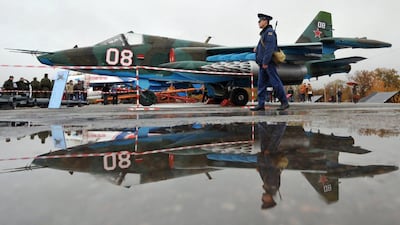BEIRUT // Saddam Hussein once prided himself on the formidable arsenal of Russian and French war planes he had at his disposal.
Iraq’s air force was one of the largest in the Middle East and used to devastating effect during the war against Iran in the 1980s.
Today, Iraq barely has an air force to speak of, despite the United States spending $20 billion (Dh73.5bn) since 2003 to rebuild the country’s military.
A series of delayed arms deals, the slow recovery from multiple wars, and government mismanagement means air power has been virtually absent as Baghdad struggles to dislodge militants now in control of large areas of the country’s north and west.
While the delivery of five Russian warplanes on Saturday brings badly needed firepower, analysts doubt the new aircraft can turn the tide against the insurgency led by the Islamic State and driven by Sunni anger at the government.
In total, Iraq will receive 12 Russian made Sukhoi Su-25s, designed to provide air support to troops operating on the ground. The Soviet-era, twin-engined jet is easy to fly and, despite first being introduced three decades ago, is still used by dozens of militaries, including Bashar Al Assad’s forces in Syria.
“The Russians did them [the Iraqis] a favour with these SU-25,” said Thomas Keaney, a retired US air force colonel and associate director of strategic studies at the School of Advanced International Studies in Washington.
“It’s low-tech, relatively easy to fly, very forgiving and it’s mainly designed to be slow to provide close air support.”
Before the first Gulf War, Saddam’s air force included dozens of SU-25s amid a large fleet of mostly-ageing fast jets.
The air force was devastated by the US and its allies when the war started in 1991. More than 100 jets were flown to Iran by Iraqi pilots fleeing the bombardment where they were impounded and remain to this day.
Iraq’s air force never recovered. It remains devoid of aircraft and the country has a shortage of trained pilots.
It has only three fixed-wing attack aircraft and four attack helicopters, according to Global Firepower, an online military database. Since militants started to take control of sections of Anbar province earlier this year, the Iraqi military has used training aircraft, Cessna turboprop planes converted to carry US-made hellfire missiles, and a small number of largely Russian helicopters to attack the insurgents.
“After years of counterinsurgency effort by the US, the Iraqi air force didn’t have itself a ground attack capability,” said Yezid Sayigh, a senior associate at the Carnegie Middle East Center in Beirut.
He questioned the expensive arms deals that Iraq’s government had entered into with the US and Russia since 2008.
These include a $4.2bn deal for 36 F-16 US-made fighter jets as well as a $4.3bn deal for 44 Russian-made military helicopters.
The latter was signed in 2012 but its initial implementation was reportedly halted by Iraq because of internal corruption concerns.
“The Iraqi air force has not necessarily been buying what it needs most,” said Mr Sayigh, adding that Iraqi corruption is suspected of driving those deals.
Christopher Harmer, a former US naval aviator and Middle East military analyst at the Institute for the Study of War, said too little was done to arm Iraq’s air force when the US withdrew in December 2011, eight years after toppling Saddam.
“We left Iraq when the Iraqis didn’t have a functional air force,” he said.
The US should have expedited the delivery of F-16s fighter jets to Baghdad years ago, he said. The planes are now only expected to arrive in September.
Mr Harmer expressed concerns that the delay gave US competitors, Russia and especially Iran, ample opportunity to increase their influence over Iraq by jumping to its aid.
“This has opened the door to Iranians to make huge inroads with the Iraqi government,” Mr Harmer said.
Others blame Mr Al Maliki for the delays in the delivery of the F-16 fighter jets. After coming to an agreement with the manufacturer, Lockheed Martin Corp, in 2011, the Iraqi premier temporarily backtracked and demanded that Washington foot the bill, said Rick Brennan, a political analyst at the Rand Corporation and former adviser to the US military in Iraq.
“The delay is primarily a response of the government of Iraq dragging its feet and being unwilling to pay for the number of jets it wanted to have,” said Rick Brennan, a political scientist at the Rand Corporation and former adviser to the US military in Iraq.
Since the US withdrawal of tens of thousands of its troops in 2011, Mr Al Maliki was able to insert loyalists, many of them his fellow Shiites, into top positions within the military at the expense of more qualified officers, he said.
Iraq is now scrambling to put together a fleet of aircraft which may help in the battle against the Islamic State, which until earlier this week called themselves the Islamic State of Iraq and the Levant. The government has even started negotiations with Iran to return the jets that were flown there in 1991.
Whatever the state of the air force, the grievances of Iraq’s Sunni minority meant any aerial assault would be seen as a sectarian attack by Mr Al Maliki, said Elias Hanna, a retired general in the Lebanese military now working at the American University of Beirut.
“You’re not talking about a conventional military solution here,” he said.
Mr Hanna added that there were also fears of new military hardware falling into the hands of the militants.
Western arms suppliers would likely think twice about selling weapon systems to a government that had already lost US-made Humvees and other armaments to the Islamic State, an Al Qaeda-splinter group.
hnaylor@thenational.ae

